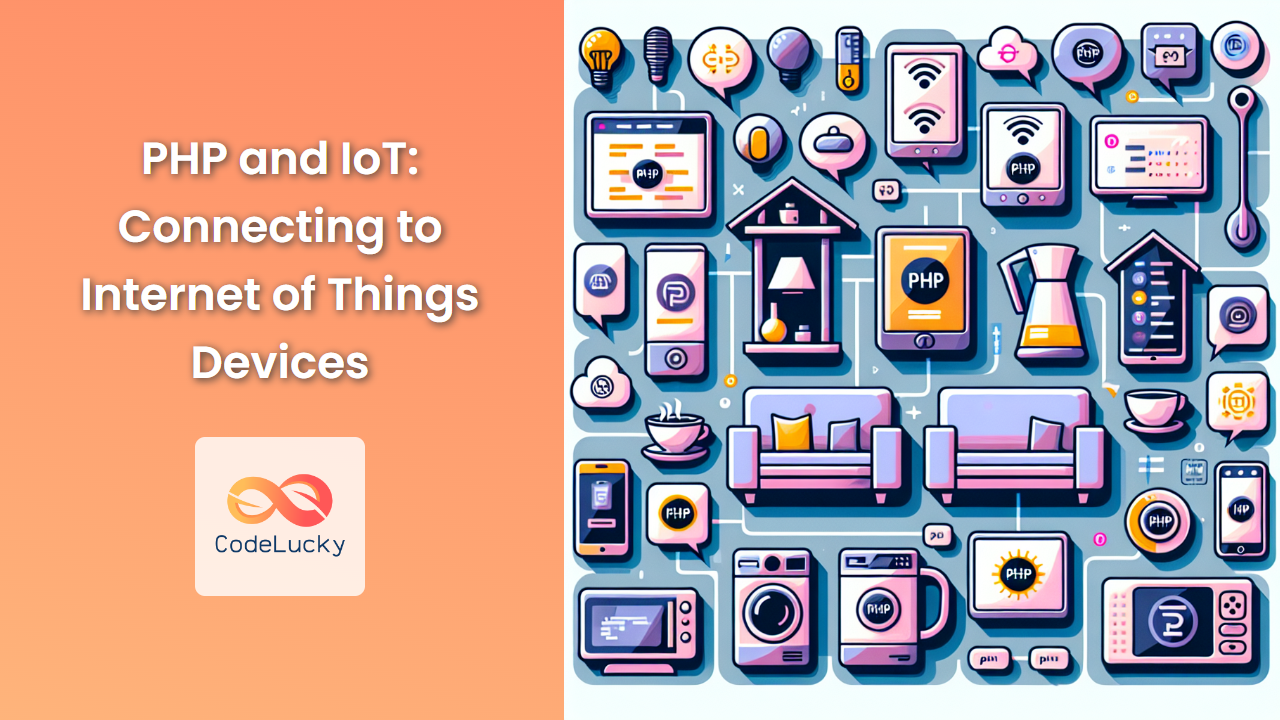In today's interconnected world, the Internet of Things (IoT) has become an integral part of our daily lives. From smart home devices to industrial sensors, IoT is revolutionizing how we interact with technology. As a PHP developer, you might wonder how you can leverage your skills to tap into this exciting field. In this comprehensive guide, we'll explore how PHP can be used to connect to and interact with IoT devices, opening up a world of possibilities for your web applications.
Understanding IoT and Its Connection to PHP
🌐 The Internet of Things refers to the network of physical devices embedded with electronics, software, sensors, and network connectivity, which enables these objects to collect and exchange data. While IoT devices often use lightweight protocols and languages, PHP – traditionally a server-side language – can play a crucial role in processing, storing, and visualizing data from these devices.
Setting Up Your PHP Environment for IoT
Before we dive into connecting PHP with IoT devices, let's ensure our development environment is ready:
- Install PHP 7.4 or higher
- Enable necessary extensions (curl, json, mqtt)
- Install Composer for package management
Here's a quick check to ensure your PHP installation is IoT-ready:
<?php
// Check PHP version
echo "PHP Version: " . phpversion() . "\n";
// Check if required extensions are installed
$required_extensions = ['curl', 'json', 'mqtt'];
foreach ($required_extensions as $ext) {
if (extension_loaded($ext)) {
echo "$ext extension is installed.\n";
} else {
echo "Warning: $ext extension is not installed.\n";
}
}
Run this script, and you should see output similar to:
PHP Version: 7.4.16
curl extension is installed.
json extension is installed.
mqtt extension is installed.
If you're missing any extensions, you'll need to install them before proceeding.
Connecting to IoT Devices: Common Protocols
IoT devices use various protocols for communication. Let's explore how PHP can interact with some of the most common ones:
1. HTTP/HTTPS
Many IoT devices expose RESTful APIs that can be accessed via HTTP/HTTPS. PHP's cURL extension is perfect for this purpose.
Example: Fetching data from a weather station API
<?php
function getWeatherData($apiKey, $location) {
$url = "https://api.weatherstation.io/current?key=$apiKey&location=$location";
$ch = curl_init($url);
curl_setopt($ch, CURLOPT_RETURNTRANSFER, true);
$response = curl_exec($ch);
if (curl_errno($ch)) {
throw new Exception(curl_error($ch));
}
curl_close($ch);
return json_decode($response, true);
}
try {
$apiKey = 'your_api_key_here';
$location = 'New York';
$weatherData = getWeatherData($apiKey, $location);
echo "Current temperature in $location: " . $weatherData['temperature'] . "°C\n";
echo "Humidity: " . $weatherData['humidity'] . "%\n";
} catch (Exception $e) {
echo "Error: " . $e->getMessage();
}
This script fetches current weather data from a hypothetical weather station API. It demonstrates how to make HTTP requests, handle responses, and process JSON data – all common tasks when working with IoT devices.
2. MQTT (Message Queuing Telemetry Transport)
MQTT is a lightweight messaging protocol ideal for IoT devices with limited resources. PHP can interact with MQTT brokers using the phpMQTT library.
First, install phpMQTT using Composer:
composer require bluerhinos/phpmqtt
Example: Subscribing to an MQTT topic to receive sensor data
<?php
require('vendor/autoload.php');
use Bluerhinos\phpMQTT\phpMQTT;
$server = "mqtt.example.com";
$port = 1883;
$username = "your_username";
$password = "your_password";
$client_id = "php_mqtt_client_" . rand();
$mqtt = new phpMQTT($server, $port, $client_id);
if ($mqtt->connect(true, NULL, $username, $password)) {
echo "Connected to MQTT Broker\n";
$topics['sensors/temperature'] = array("qos" => 0, "function" => "processTempData");
$mqtt->subscribe($topics, 0);
while($mqtt->proc()) {
// Handle incoming messages
}
$mqtt->close();
} else {
echo "Failed to connect to MQTT Broker\n";
}
function processTempData($topic, $message) {
echo "Received temperature data: $message°C\n";
// Process the data (e.g., store in database, trigger alerts)
}
This script connects to an MQTT broker, subscribes to a temperature sensor topic, and processes incoming messages. It's a great starting point for building more complex IoT applications with PHP.
3. WebSockets
WebSockets provide full-duplex communication channels over a single TCP connection, making them ideal for real-time IoT applications. PHP can use the Ratchet library to work with WebSockets.
Install Ratchet using Composer:
composer require cboden/ratchet
Example: Creating a WebSocket server to handle IoT device connections
<?php
require 'vendor/autoload.php';
use Ratchet\Server\IoServer;
use Ratchet\Http\HttpServer;
use Ratchet\WebSocket\WsServer;
use Ratchet\MessageComponentInterface;
use Ratchet\ConnectionInterface;
class IoTDevice implements MessageComponentInterface {
protected $clients;
public function __construct() {
$this->clients = new \SplObjectStorage;
}
public function onOpen(ConnectionInterface $conn) {
$this->clients->attach($conn);
echo "New connection! ({$conn->resourceId})\n";
}
public function onMessage(ConnectionInterface $from, $msg) {
$numRecv = count($this->clients) - 1;
echo sprintf('Device %d sent message "%s" to %d other devices' . "\n"
, $from->resourceId, $msg, $numRecv);
foreach ($this->clients as $client) {
if ($from !== $client) {
$client->send($msg);
}
}
}
public function onClose(ConnectionInterface $conn) {
$this->clients->detach($conn);
echo "Connection {$conn->resourceId} has disconnected\n";
}
public function onError(ConnectionInterface $conn, \Exception $e) {
echo "An error has occurred: {$e->getMessage()}\n";
$conn->close();
}
}
$server = IoServer::factory(
new HttpServer(
new WsServer(
new IoTDevice()
)
),
8080
);
echo "WebSocket server started on port 8080\n";
$server->run();
This script creates a WebSocket server that can handle multiple IoT device connections, broadcast messages, and manage connection lifecycle events. It's an excellent foundation for building scalable, real-time IoT applications with PHP.
Storing and Analyzing IoT Data
Once you're receiving data from IoT devices, you'll likely want to store and analyze it. Here's a simple example of how to store sensor readings in a MySQL database:
<?php
$servername = "localhost";
$username = "your_username";
$password = "your_password";
$dbname = "iot_data";
try {
$conn = new PDO("mysql:host=$servername;dbname=$dbname", $username, $password);
$conn->setAttribute(PDO::ATTR_ERRMODE, PDO::ERRMODE_EXCEPTION);
$stmt = $conn->prepare("INSERT INTO sensor_readings (device_id, sensor_type, value, timestamp) VALUES (:device_id, :sensor_type, :value, :timestamp)");
$stmt->bindParam(':device_id', $device_id);
$stmt->bindParam(':sensor_type', $sensor_type);
$stmt->bindParam(':value', $value);
$stmt->bindParam(':timestamp', $timestamp);
// Sample data
$device_id = 'temp_sensor_01';
$sensor_type = 'temperature';
$value = 23.5;
$timestamp = date('Y-m-d H:i:s');
$stmt->execute();
echo "New sensor reading recorded successfully";
} catch(PDOException $e) {
echo "Error: " . $e->getMessage();
}
$conn = null;
This script demonstrates how to securely insert IoT sensor data into a MySQL database using PDO. You can expand on this to include data analysis, visualization, or even machine learning algorithms to derive insights from your IoT data.
Security Considerations
🔒 When working with IoT devices, security should be a top priority. Here are some key points to consider:
- Use HTTPS for all web communications
- Implement proper authentication and authorization for your APIs
- Encrypt sensitive data both in transit and at rest
- Regularly update your PHP version and all dependencies
- Implement rate limiting to prevent DoS attacks
- Use prepared statements to prevent SQL injection
Example: Implementing basic API key authentication
<?php
function authenticateRequest($apiKey) {
$validApiKeys = ['abc123', 'def456']; // Store these securely in practice
return in_array($apiKey, $validApiKeys);
}
$headers = getallheaders();
if (isset($headers['X-API-Key']) && authenticateRequest($headers['X-API-Key'])) {
// Process the authenticated request
echo "Request authenticated successfully";
} else {
http_response_code(401);
echo "Unauthorized";
}
This simple example shows how to implement basic API key authentication. In a production environment, you'd want to use more robust authentication methods and store API keys securely.
Conclusion
PHP's versatility makes it an excellent choice for building IoT applications. Whether you're collecting data from sensors, controlling smart home devices, or analyzing industrial IoT data, PHP provides the tools and flexibility to bring your IoT projects to life.
As you continue to explore the intersection of PHP and IoT, remember to stay updated with the latest PHP features and IoT protocols. The field is rapidly evolving, and staying informed will help you create more efficient, secure, and innovative IoT solutions.
By mastering these concepts and techniques, you'll be well-equipped to leverage PHP in the exciting world of IoT, creating powerful applications that bridge the physical and digital realms. Happy coding, and may your PHP-powered IoT projects flourish! 🚀🌟



















